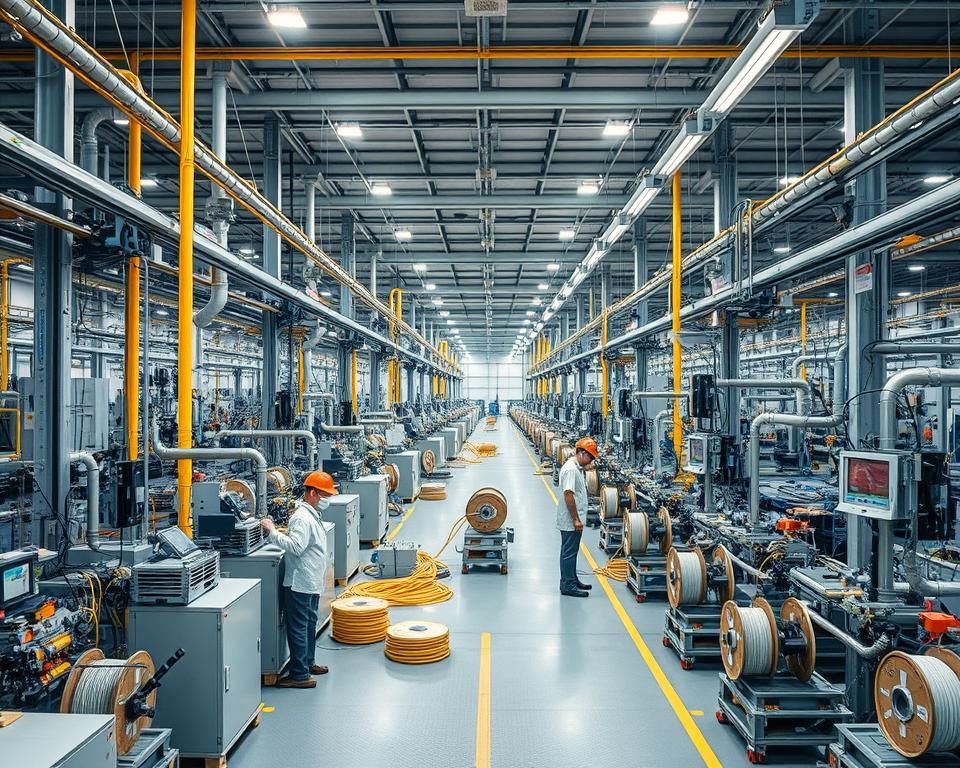Ultimate Guide to FTTH cable Production Line
Here’s a complete overview of the FTTH cable production line. We will explore the world of fiber optic cables in this comprehensive article, focusing on their critical role in enabling high-speed data transmission. With the ever-increasing need for quicker and more dependable internet connectivity, grasping the complexities of FTTH cable production is now vital. You will gain valuable insights into the production of FTTH cable production line through this guide, which ranges from the basics of cable infrastructure to the sequential manufacturing process.
Whether you are new to the industry or looking to enhance your knowledge, this guide has you covered. You’ll learn about the key components of FTTH cable systems, the part played by optical fibers in FTTH technology, and the process of converting raw materials into high-quality fiber optic cables. Moreover, we will examine design considerations, stranding techniques, buffering and jacketing processes, and the efficient working of the FTTH cable production line.
Stay tuned for the advanced technologies transforming FTTH cable manufacturing, as well as the importance of testing and quality assurance in ensuring the reliability and durability of fiber optic cables. We’ll also discuss the last stages of packaging and distribution, making sure the FTTH cable production line works without any issues from start to finish.
Main Points:
- The FTTH cable production line is essential for delivering high-speed data transmission.
- The fundamentals of FTTH cable infrastructure and its key components are crucial to understand.
- The step-by-step production of FTTH cable, starting with silica and resulting in fiber, includes fiber drawing, coating application, and testing.
- To optimize performance, it’s important to design configurations and layouts that meet specific network requirements.
- The fiber gains support and protection from stranding techniques and central strength members.
An Introduction to FTTH cable Production
A clear understanding of the cable infrastructure, key components, and the role of optical fibers in FTTH technology is essential to comprehend the FTTH cable production process.
Essential Aspects of FTTH cable Infrastructure
This network of cables, connectors, and distribution points, which enables data transmission in fiber-to-the-home (FTTH) systems, is what we call the FTTH cable infrastructure. It forms the backbone of high-speed internet connectivity, allowing for seamless data transfer between the provider’s network and the end user’s premises.

Essential Elements of FTTH cable Systems
Several key components collaborate in FTTH cable systems to guarantee the smooth and efficient transmission of data. These components include:
- Fiber optic cables: These cables are responsible for carrying the data signals in the form of light. Ensuring fast and reliable data transmission, they are designed to provide high bandwidth and low signal loss.
- Joining fiber optic cables to other cables or devices is a crucial role of connectors, which also facilitate connection and disconnection when needed. A secure and reliable connection is provided by them, which helps minimize signal loss.
- The division and distribution of fiber optic signals to multiple end users is the function of distribution points. Their purpose is to help each user receive the correct amount of bandwidth while maintaining the overall network performance.
How Optical Fibers Contribute to FTTH Technology
The most important part of FTTH technology is optical fibers. Made of thin strands of glass or plastic, they are designed to efficiently transmit data signals in the form of light pulses. Because of their high bandwidth capacity, low signal loss, and immunity to electromagnetic interference, optical fibers are perfect for high-speed data transmission.
A core that carries light signals is at the center of these fibers, and it’s surrounded by a cladding layer that reflects the light back into the core, thus preventing signal loss. This construction allows optical fibers to transmit data over long distances without degradation in signal quality or speed.
Step-by-Step Process: From Silica to Fiber
Creating the Core: The Fiber Drawing Process
In the FTTH cable production process, the first step is fiber drawing, which involves crafting the core of the cable. A glass preform made of silica is pulled and stretched in this process, turning it into a long, thin fiber. The diameter of the fiber is precisely controlled during fiber drawing to guarantee optimal performance. The core’s quality and composition play a crucial role in determining the cable’s ability to transmit data efficiently and accurately.
How Coating Application Ensures the cable’s Durability
After the fiber drawing process, the next step is coating application. In this stage, a protective layer, known as a coating, is applied to the fiber. The coating has several roles, including acting as a buffer against external factors like moisture, which improves the fiber’s long-term durability and reliability. The coating material is also carefully selected to have the necessary mechanical properties, guaranteeing that the fiber remains intact and protected during its entire lifespan.
Testing for Quality: Fiber Testing in the Production Process
Throughout the FTTH cable production process, fiber testing is conducted at various stages to verify the quality and performance of the fiber. Testings include measuring the fiber’s physical parameters such as diameter, attenuation, and tensile strength, as well as inspecting the coating’s uniformity and adhesion properties. The overall quality and performance of the final FTTH cables are guaranteed by these crucial tests, which ensure the fiber meets the necessary standards and specifications.
| Production Stage | Testing Parameters |
|---|---|
| Fiber Drawing | Diameter, Attenuation, Tensile Strength |
| Coating Application | Coating Thickness, Uniformity, Adhesion |
FTTH cable Production: Testing Parameters at Different Stages (Table)
The table above summarizes the testing parameters measured at different stages of the FTTH cable production process. Rigorous testing allows manufacturers to guarantee that each fiber used in the cables meets the required quality standards, ultimately contributing to the high-performance and reliability of FTTH cable systems.
Designing FTTH cable Configurations
In the realm of fiber-to-the-home (FTTH) cable production, cable configuration design is key to fulfilling network requirements and optimizing performance. Factors like network capacity, how easily it can be expanded, and the desired speed of data transmission are all part of cable design. Customizing cable configurations to fit specific needs allows companies to deploy their network infrastructure efficiently and get the most out of it.
When it comes to FTTH cables, there are many different configurations and layouts available, each with its own benefits and things to think about:
- The main distribution point is connected to each subscriber in a sequential manner in the Daisy Chain Configuration. This cost-effective solution is ideal for regions with a low number of subscribers.
- In the star configuration, the central office or hub is directly connected to each subscriber. Flexibility and ease of maintenance are features of this design, making it perfect for densely populated areas.
- In the ring configuration, subscribers are connected to form a circular loop. If the network fails, it still provides service without interruption because it has redundancy and can tolerate faults.
- A tree configuration involves the main distribution point connecting to secondary distribution points, which in turn connect to individual subscribers. This configuration allows the network to grow easily and is often used in areas where there are a lot of subscribers.
- With multiple connections between distribution points, the mesh configuration offers high reliability and redundancy. Applications where uninterrupted service is absolutely necessary often use this configuration.
When you’re designing FTTH cable configurations, you need to take into account what the network needs and how much it’s likely to grow. Factors such as how many subscribers there are, the geographical area, and what services are required will determine which configuration is best, as each has its own advantages and limitations.
Careful evaluation of these factors, along with collaboration with industry experts, enables companies to design FTTH cable configurations that are specifically suited to their network requirements and provide optimal performance.
Equipment and Techniques Used in Stranding
The production of strong and durable FTTH cables relies heavily on the stranding techniques and equipment employed. Different stranding patterns are employed, each with its own advantages and applications. For cable production that is both efficient and of high quality, it’s essential to choose the right stranding machinery. Furthermore, the fiber receives extra support and protection from central strength members, which helps make the FTTH cables more reliable.
Understanding the Different Stranding Patterns
When producing FTTH cables, one of the main things to consider is which stranding pattern to use. Depending on what characteristics are desired in the cable, different stranding patterns are used, such as reverse concentric, SZ stranding, and helical stranding. In terms of flexibility, strength, and how well it resists external factors, each pattern has unique features that can improve the cable’s performance. Stranding patterns are carefully chosen to meet specific application requirements, ensuring optimal performance and longevity of the FTTH cables.
How to Choose Stranding Machinery
The FTTH cable production line relies heavily on stranding machinery. The stranding pattern can be precisely formed thanks to this machinery, which also keeps the fibers at the necessary tension and in the correct alignment. The diameter of the cable, how fast you need to produce it, and how much automation you want are all factors that will help you choose the right fiber secondary coating line machinery. Because advanced stranding machines are more efficient and flexible, manufacturers can produce a large number of cables and also offer customization.
Central Strength Members: Their Purpose
FTTH cables use central strength members to make them mechanically stronger. Stability is provided, tensile strength is improved, and the delicate fiber inside the cable is protected by them. Typically made of materials like aramid or fiberglass, the central strength members act as a backbone, reinforcing the cable structure and offering resistance against external forces. FTTH cables are able to withstand the stresses of installation and maintain the quality of signal transmission thanks to them, which makes them suitable for different deployment scenarios.
Fiber Protection: Buffering and Jacketing
The protection of the delicate fiber within FTTH cables relies heavily on the buffering and jacketing processes during production. The fiber is shielded from a variety of potential threats, including moisture, abrasion, and other external factors that could negatively impact its performance and lifespan, thanks to these processes.
The Buffering Process and Its Importance
Applying a protective layer around the fiber is what the buffering process involves, and this layer acts as a barrier against environmental elements. This layer prevents water penetration, which can cause signal loss or even breakage of the fiber. In addition, buffering enhances the cable’s ability to withstand rubbing, which reduces the likelihood of damage when it’s installed or being worked on.
The buffering materials used must exhibit excellent adhesion to the fiber and possess a low coefficient of friction to minimize stress on the fiber. Choosing the right buffering material depends on things like what kind of environment the cable will be in and how much protection is needed.
Choosing the Right Materials for Jacketing
Putting an outer layer on to give extra protection to the fiber and the buffering materials is what jacketing involves. The jacketing material is specifically chosen to provide robust protection against mechanical stress, impact, UV radiation, and other potential hazards.
Things like flexibility, how well it resists fire, and its compatibility with the environment are all factors that are considered when choosing jacketing materials. Polyethylene (PE), polyvinyl chloride (PVC), and low-smoke zero-halogen (LSZH) compounds are some of the common materials used for jacketing. Each material has its own set of advantages and disadvantages, and the choice depends on the specific application and industry standards.
Applying the Latest Jacketing Technologies
Jacketing technologies have come a long way, and these advancements have completely changed how FTTH cables are protected. These latest technologies provide better strength, more flexibility, and improved resistance to environmental factors, leading to greater durability and reliability.
Tight-buffered cables are one of the new jacketing technologies, and they involve buffering each fiber with a thin layer of plastic, which gives great protection and flexibility. Micro-ducts, another technology, use strong tubing to contain multiple fibers, offering high density and making cable installation versatile.
Furthermore, there are specialized jacketing technologies designed to meet specific industry requirements. Cables that are used in tough outdoor conditions, for instance, might have armored jackets to protect them better from rodents, moisture, and extreme temperatures.
Using the newest jacketing technologies allows FTTH cables to be made specifically for different uses, which ensures they work as well as possible, last a long time, and are reliable.
Understanding Operations in the FTTH cable Production Line
The FTTH cable production line relies on efficient operations to ensure a smooth and streamlined manufacturing process. Every step in the production line is vital for creating high-quality fiber optic cables that make high-speed internet connectivity possible. To achieve optimal efficiency, various machinery and equipment are utilized.
Raw materials are prepared first in the manufacturing process, and this includes the silica that will be used for fiber drawing. After that, the fiber drawing process starts, and the cable’s core is carefully crafted to meet the desired specifications. Following fiber drawing, coating application is performed to ensure the fiber’s durability and protection.
The highest standards for the cables are ensured by making quality a top priority and conducting rigorous fiber testing at every stage of the production line. Factors such as attenuation, bandwidth, and signal loss are all tested as part of this process.
Efficiency is a key factor in the operations of the FTTH cable production line. Optimizing the use of machinery and equipment allows manufacturers to reduce production time and costs and increase the amount they produce. Furthermore, when the processes are efficient, the quality of the cables is generally better.
With its various stages and components, the manufacturing process can be quite complex. But, if manufacturers use efficient operations and constantly try to make things better, they can enhance how well and effectively their FTTH cable production line works.
The table below provides a summary of the key machinery involved in the FTTH cable production line and their respective roles in the manufacturing process, giving you a comprehensive understanding of the operations:
| Machine | Role |
|---|---|
| Fiber Drawing Machine | Produces the fiber optic cable core by pulling and stretching the silica material. |
| Coating Machine | Applies a protective coating to the fiber optic cable, ensuring durability and resistance to external factors. |
| Fiber Testing Equipment | Conducts various tests on the fiber optic cable to ensure quality and performance. |
| Spooling Machine | Winds the finished fiber optic cable onto spools for packaging and distribution. |
| Jacketing Machine | Applies an outer jacket to the fiber optic cable, providing additional protection and enhancing its handling. |
Using advanced machinery and technologies allows manufacturers to make their production line operations more streamlined, enhance efficiency, and deliver high-quality FTTH cables that meet the rising demand for high-speed internet connectivity.
Advanced Technologies in FTTH cable Manufacturing
For the FTTH (Fiber to the Home) cable manufacturing field, which is always evolving, advanced technologies are key to enhancing efficiency and quality. Automation, AI integration, and fiber coloring machines have completely changed the production process due to the increasing demand for high-speed data transmission, which has driven innovation and led to the creation of superior products.
Benefits of Automation in Fiber Optic cable Production
Automation has had a big impact on how fiber optic cables are manufactured. With advanced machinery and robotics, the manufacturing process can be controlled with great precision, ensuring consistent quality and minimizing errors. Because of this automation, more cables can be produced faster and with better accuracy, which ultimately saves money and makes customers happier.
AI in Quality Control for cable Manufacturing
FTTH cable manufacturers can reach unprecedented levels of accuracy and reliability by integrating artificial intelligence (AI) into their quality control process. As production data is generated, AI algorithms can analyze it in real-time, identifying any changes or irregularities that could affect the quality of the cables. Taking a proactive approach to quality control helps to reduce errors, make production more efficient, and ensure that only the highest quality FTTH cables are made available to customers.
Capabilities of Fiber Coloring Machines
FTTH cable manufacturing has been completely changed by the introduction of fiber coloring machines, which offer better ways to customize the cables. With fiber coloring machines, optical fiber strands can be color-coded, which makes it easy to identify them and manage the cables efficiently during installation and maintenance. The need for manual color coding is eliminated by this technology, which also reduces the risk of errors and makes cable deployment more efficient overall.
Fiber Optics: Ensuring Quality Through Testing and Assurance
Making sure the quality is the best it can be is very important in the field of fiber optics. This goal is reached by implementing thorough testing and quality assurance measures at every stage of the production process. Standardized testing protocols play a crucial role in guaranteeing the reliability and consistency of fiber optic cables.
The Importance of Standardized Testing Protocols
Standardized testing protocols are set up to guarantee that each and every fiber optic cable meets the necessary quality standards. At each stage of the production process, these protocols specify the testing procedures and criteria that must be followed. These protocols help manufacturers identify and resolve any potential issues, ensuring that only the highest quality cables are provided to customers.
OTDR: A Key Tool for Quality Checks
Performing quality checks on fiber optic cables relies heavily on the use of Optical Time-Domain Reflectometer (OTDR). OTDR is a testing instrument that sends light pulses to measure the amount of signal loss and reflection along an optical fiber. Technicians can identify problems like fiber bending, signal loss, or damage to the connectors by analyzing the OTDR traces. This helps them find exactly where any problems are and fix them, which makes sure the cable is of good quality and works well.
The Importance of Maintaining Strict Quality Assurance Standards
The consistent and reliable performance of fiber optic cables is ensured by maintaining quality assurance standards throughout the entire production process. Material selection, how the cables are made, and testing of the final product are all covered by these standards. Following these strict standards allows manufacturers to ensure that their products meet the highest quality and performance levels demanded by the industry.
The Last Steps: Packaging and Distribution of FTTH cables
The last steps in the production of Fiber coloring machine, which are packaging and distribution, are the focus of this section. Ensuring that the cables are packaged correctly and efficiently after they have gone through the various manufacturing processes is crucial for their deployment and installation in the field. Furthermore, protective packaging solutions are important for safeguarding the delicate fiber optic cables when they are being transported and stored. To make sure FTTH products get to customers on time and meet their connectivity needs, efficient logistics and supply chain management are essential.
The Importance of Efficient cable Spooling
For FTTH cables to be installed smoothly and easily, efficient techniques for spooling them are vital. cable spools provide a practical and organized way to store and transport the cables, reducing the risk of tangling or damage. By employing optimized cable spooling techniques, cable installers can save time and effort during the deployment process. When cables are spooled properly, the installation looks neater and more professional overall.
Protective Packaging Solutions for Fiber Optic cables
Effective protective packaging solutions need to be used to protect the delicate fiber optic cables while they are transported and stored. These packaging solutions should cushion the cables, absorb shocks, and protect them from things outside like moisture, dust, and being hit. Manufacturers can ensure that the fiber optic cables arrive in excellent condition and are ready for installation by using high-quality packaging materials and techniques. This not only keeps the cables in good condition but also makes customers happier by reducing the chance of damage or the cables not working as well as they should.
The Importance of Logistics and Supply Chain Management in FTTH
Efficient logistics and supply chain management are crucial for the successful delivery of FTTH products to customers. Careful planning of how the cables will be transported, stored, and distributed is involved to ensure they are delivered on time and reliably. By managing the supply chain well, delays can be minimized, products can flow smoothly, costs can be reduced, and customer service can be improved..
Final Thoughts
To summarize, the ultimate guide to the FTTH cable production line has provided a complete picture of the process involved in manufacturing fiber optic cables for high-speed internet connectivity. We have stressed the importance of the FTTH cable production line in making fast and reliable data transmission a reality throughout this article.
Seamless communication, streaming, and online activities are facilitated by fiber optic cables, which play a critical role in high-speed internet connectivity. The durability and quality of these cables are guaranteed by the step-by-step process of FTTH cable production, which goes from fiber drawing to buffering and jacketing.
Advanced technologies, such as automation and AI integration, have revolutionized the manufacturing process, increasing efficiency and accuracy. Furthermore, the reliability and performance of fiber optics are guaranteed by standardized testing protocols and strict quality assurance standards.
Packaging and distribution are the final steps in FTTH cable production, ensuring that these essential cables are efficiently deployed and protected during transportation. The expertise and precision that go into the FTTH cable production line are essential for meeting the growing need for high-speed internet connectivity worldwide.









